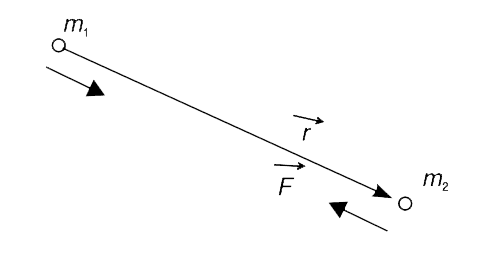Two particles of mass m1andm2 are in space at separation →r [vector from m(1) to m2]. The only force that the two particles experience is the mutual gravitational pull. The force applied by m1onm2is→F. Prove that μd2→rdt2=→F where μm1m2m1+m2 is known as reduced mass for the two particle system .

Step by step video, text & image solution for Two particles of mass m_(1) "and" m_(2) are in space at separation vecr [vector from m(1) to m_(2)]. The only force that the two particles experience is the mutual gravitational pull. The force applied by m_(1) "on" m_(2) "is" vecF . Prove that mu(d^(2)vecr)/(dt^(2)) = vecF where mu"(m_(1)m_(2))/(m_(1) + m_(2)) is known as reduced mass for the two particle system . by Physics experts to help you in doubts & scoring excellent marks in Class 11 exams.
Updated on:21/07/2023Topper's Solved these Questions
Similar Questions
Two stationary particles of masses M1 and M2 are 'd' distance apart. A third particle lying on the line joining the particles, experiences no resultant gravitational force. What is the distance of this particle from M1 ?
View SolutionPosition vector of centre of two particles of masses m1 and m2 whose position vectors r1 and r2 then rcm?
View Solution
Knowledge Check
Two particles of mass m1 and m2, approach each other due to their mutual gravitational attraction only. Then
Aacceleration of both the particles are equal.Bacceleration of the particle of mass m1 is proportional to m1Cacceleration the particle of mass m1 is proportional to m2.Daccelaration of the particle of mass m1 is inversely proportional to m1.Two particles of mass m1 and m2, approach each other due to their mutual gravitational attraction only. Then
Aaccelerations of both the particles are equal.Bacceleration of the particle of mass m1 is proportional to m1.Cacceleration of the particle of mass m1 is proportional to m2.Dacceleration of the particle of mass m1 is inversely proportional to m1.The reduce mass of two particles having masses m and 2 m is
A2 mB3 mC2 m/3Dm/2
For a two body oscillator system, prove the relation,
T=2π√μk
where, μ=m1m2m1+(m2)= reduced mass.
View Solution.Two particles of masses "m_(1)" and m_(2)(m_(1)>m_(2))" are separated by a distance ' "d" '.The shift in the centre of mass when the two particles are interchanged.
View SolutionIf two particles of masses m1 and m2 are projected vertically upwards with speed v1 and v2, then the acceleration of the centre of mass of the system is
View SolutionTwo particles of masses m1andm2 are moving in concentric circle of radii r1andr2 such that their period are same. Then the ratio of their centripetal acceleration is
View SolutionTwo stars of mass m1 and m2 are parts of a binary star system. The radii of their orbits are r1 and r2 respectivey, measured from the centre of mass of the system. The magnitude of gravitational force m1 exerts on m2 is
View Solution
